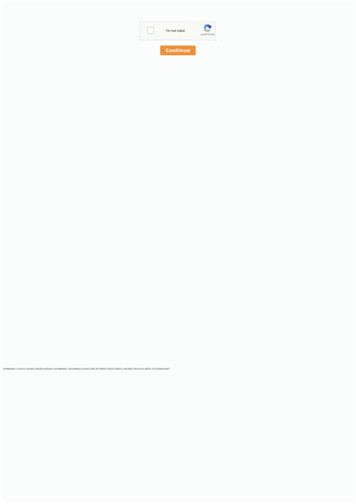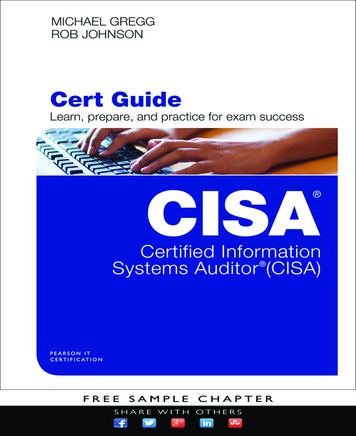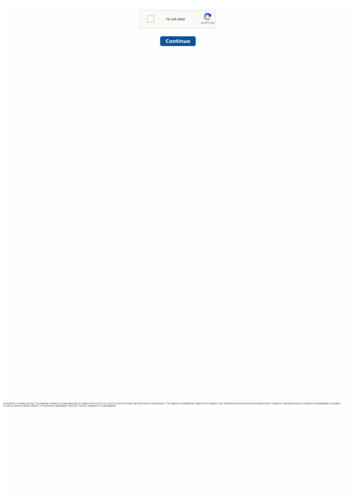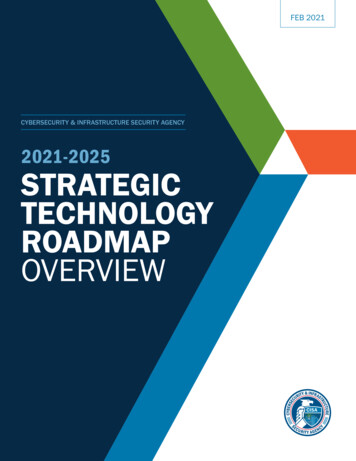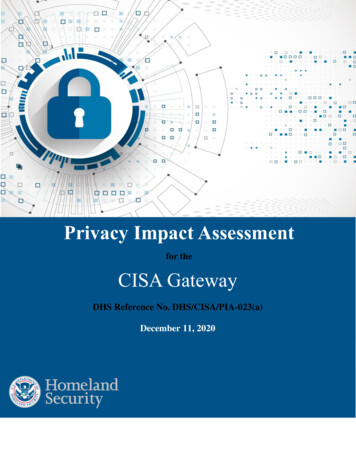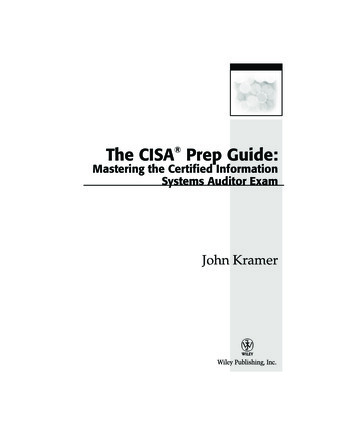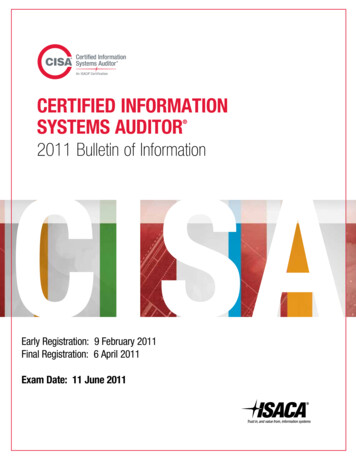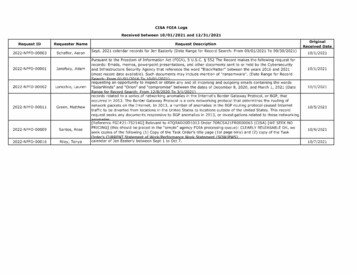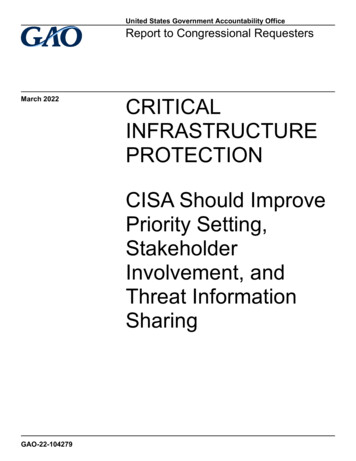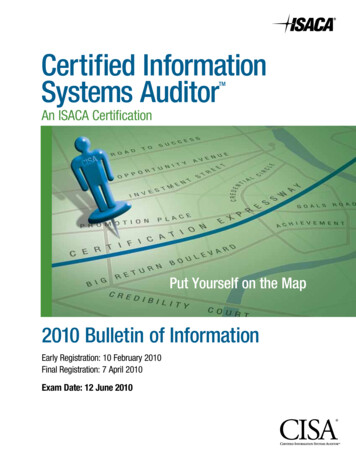
Transcription
Cisa review manual 2021 pc download
The requested URL was not found on this server. Additionally, a 404 Not Found error was encountered while trying to use an ErrorDocument to handle the request. Apache/2.4.41 (Ubuntu) Server at sourcing.gftn.panda.org Port 443 11 Edition th CISA Review Questions, Answers & Explanations Manual ISACA ISACA (isaca.org) helps globalprofessionals lead, adapt and assure trust in an evolving digital world by offering innovative and world-class knowledge, standards, networking, credentialing and career development. Established in 1969, ISACA is a global nonprofit association of 140,000 professionals in 180 countries. ISACA also offers the Cybersecurity NexusTM (CSX), a holisticcybersecurity resource, and COBIT , a business framework to govern enterprise technology. In addition, ISACA advances and validates business-critical skills and knowledge through the globally respected Certified Information Systems Auditor (CISA ), Certified Information Security Manager (CISM ), Certified in the Governance of EnterpriseIT (CGEIT ) and Certified in Risk and Information Systems ControlTM (CRISCTM) credentials. Disclaimer ISACA has designed and created CISA Review Questions, Answers & Explanations Manual 11th Edition primarily as an educational resource to assist individuals preparing to take the CISA certification exam. It was produced independentlyfrom the CISA exam and the CISA Certification Committee, which has had no responsibility for its content. Copies of past exams are not released to the public and were not made available to ISACA for preparation of this publication. ISACA makes no representations or warranties whatsoever with regard to these or other ISACA publications assuringcandidates’ passage of the CISA exam. Reservation of Rights 2015 ISACA. All rights reserved. No part of this publication may be used, copied, reproduced, modified, distributed, displayed, stored in a retrieval system or transmitted in any form by any means (electronic, mechanical, photocopying, recording or otherwise) without the prior writtenauthorization of ISACA. ISACA 3701 Algonquin Road, Suite 1010 Rolling Meadows, Illinois 60008 USA Phone: 1.847.253.1545 Fax: 1.847.253.1443 Email: [email protected] Web site: www.isaca.org Participate in the ISACA Knowledge Center: www.isaca.org/knowledge-center Follow ISACA on Twitter: Join ISACA on LinkedIn: ISACA (Official), LikeISACA on Facebook: www.facebook.com/ISACAHQ ISBN 978-1-60420-368-4 CISA Review Questions, Answers & Explanations Manual 11th Edition Printed in the United States of America CRISC is a trademark/service mark of ISACA. The mark has been applied for or registered in countries throughout the world. ii CISA Review Questions, Answers& Explanations Manual 11th Edition ISACA. All Rights Reserved. PREFACE PREFACE ISACA is pleased to offer the 1,000 questions in this CISA Review Questions, Answers & Explanations Manual 11th Edition. The purpose of this manual is to provide the CISA candidate with sample questions and testing topics to help prepare and study for theCISA exam. The material in this manual consists of 1,000 multiple-choice study questions, answers and explanations, which are organized according to the newly revised (effective 2016) CISA job practice domains. These questions, answers and explanations are intended to introduce CISA candidates to the types of questions that may appear on theCISA exam. They are not actual questions from the exam. All of these items appeared in previous editions of the CISA Review Questions, Answers & Explanations Manual and/or supplements, but many have been rewritten or enhanced to be more representative of actual exam items and to provide further clarity or reflect a change in practice. The1,000 questions are sorted by CISA domains. Additionally, 150 questions have been extracted to provide a sample test with questions in the same proportion as the current CISA job practice. The candidate also may want to obtain a copy of the CISA Review Manual 26th Edition, which provides the foundational knowledge of a CISA. The CISA Review Questions, Answers & Explanations Database 12 Month Subscription contains the same questions found in this manual in a web-based application. Finally, the candidate may also want to utilize the CISA Online Review course (www.isaca.org/elearning) for exam preparation. A job practice study is conducted at least every five years to ensurethat the CISA certification is current and relevant. Further details regarding the new job practice can be found in the section titled New CISA Job Practice. ISACA has produced this publication as an educational resource to assist individuals preparing to take the CISA exam. It was produced independently from the CISA Certification Committee,which has no responsibility for its content. Copies of past exams are not released to the public and are not made available to candidates. ISACA makes no representations or warranties whatsoever with regard to these or other ISACA or IT Governance Institute publications assuring candidates’ passage of the CISA exam. ISACA wishes you successwith the CISA exam. Your commitment to pursuing the leading certification for information systems (IS) audit, assurance, security and control professionals is exemplary, and we welcome your comments and suggestions on the use and coverage of this manual. Once you have completed the exam, please take a moment to complete the onlineevaluation that corresponds to this publication (www.isaca.org/studyaidsevaluation). Your observations will be invaluable as new questions, answers and explanations are prepared. CISA Review Questions, Answers & Explanations Manual 11th Edition ISACA. All Rights Reserved. iii ACKNOWLEDGMENTS ACKNOWLEDGMENTS This CISA ReviewQuestions, Answers & Explanations Manual 11th Edition is the result of the collective efforts of many volunteers. ISACA members from throughout the world participated, generously offering their talents and expertise. This international team exhibited a spirit and selflessness that has become the hallmark of contributors to this valuable manual.Their participation and insight are truly appreciated. iv CISA Review Questions, Answers & Explanations Manual 11th Edition ISACA. All Rights Reserved. NEW—CISA JOB PRACTICE NEW—CISA JOB PRACTICE BEGINNING IN 2016, THE CISA EXAM WILL TEST THE NEW CISA JOB PRACTICE. An international job practice analysis is conducted atleast every five years or sooner to maintain the validity of the CISA certification program. A new job practice forms the basis of the CISA exam beginning in June 2016. The primary focus of the job practice is the current tasks performed and the knowledge used by CISAs. By gathering evidence of the current work practice of CISAs, ISACA is able toensure that the CISA program continues to meet the high standards for the certification of professionals throughout the world. The findings of the CISA job practice analysis are carefully considered and directly influence the development of new test specifications to ensure that the CISA exam reflects the most current good practices. The new 2016job practice reflects the areas of study to be tested and is compared below to the previous job practice. The complete CISA job practice can be found at www.isaca.org/cisajobpractice. Previous CISA Job Practice New 2016 CISA Job Practice Domain 1: T he Process of Auditing Information Systems (14%) Domain 2: Governance and Management of IT(14%) Domain 3: I nformation Systems Acquisition, Development and Implementation (19%) Domain 4: I nformation Systems Operations, Maintenance and Support (23%) Domain 5: Protection of Information Assets (30%) Domain 1: The Process of Auditing Information Systems (21%) Domain 2: Governance and Management of IT (16%) Domain 3: Information Systems Acquisition, Development and Implementation (18%) Domain 4: Information Systems Operations, Maintenance and Service Management (20%) Domain 5: Protection of Information Assets (25%) CISA Review Questions, Answers & Explanations Manual 11th Edition ISACA. All Rights Reserved. v Page intentionally left blank viCISA Review Questions, Answers & Explanations Manual 11th Edition ISACA. All Rights Reserved. TABLE OF CONTENTS TABLE OF CONTENTS PREFACE.iiiACKNOWLEDGMENTS.iv NEW—CISA JOB PRACTICE .v INTRODUCTION.ixOVERVIEW.ix TYPES OF QUESTIONS ON THE CISA EXAM.ix PRETEST.xiQUESTIONS, ANSWERS AND EXPLANATIONS BY DOMAIN.1 DOMAIN 1—THE PROCESS OF AUDITING INFORMATION SYSTEMS (21%).1 DOMAIN 2—GOVERNANCE AND MANAGEMENT OF IT (16%).73 DOMAIN 3— INFORMATION SYSTEMS ACQUISITION, DEVELOPMENT AND IMPLEMENTATION (18%).159 DOMAIN 4— INFORMATION SYSTEMS OPERATIONS, MAINTENANCE AND SERVICE MANAGEMENT (20%).249 DOMAIN 5—PROTECTION OF INFORMATION ASSETS (25%).353 POSTTEST. 483 SAMPLE EXAM. 485 SAMPLE EXAMANSWER AND REFERENCE KEY.509 SAMPLE EXAM ANSWER SHEET (PRETEST). 511 SAMPLE EXAM ANSWER SHEET (POSTTEST). 513EVALUATION. 515 CISA Review Questions, Answers & Explanations Manual 11th Edition ISACA. All Rights Reserved. vii Page intentionally left blank viii CISA Review Questions, Answers & Explanations Manual 11th Edition ISACA. All Rights Reserved.INTRODUCTION INTRODUCTION OVERVIEW This manual consists of 1,000 multiple-choice questions, answers and explanations (numbered A1-1, A2-1, etc.). These questions are selected and provided in two formats. Questions Sorted by Domain Questions, answers and explanations are provided (sorted) by the CISA job practice domains. Thisallows the CISA candidate to refer to specific questions to evaluate comprehension of the topics covered within each domain. These questions are representative of CISA questions, although they are not actual exam items. They are provided to assist the CISA candidate in understanding the materials in the CISA Review Manual 26th Edition and todepict the type of question format typically found on the CISA exam. The numbers of questions, answers and explanations provided in the five domain chapters in this publication provide the CISA candidate with the maximum number of study questions. Sample Exam A random sample exam of 150 questions is also provided in this manual. This examis organized according to the domain percentages specified in the CISA job practice and used on the CISA exam: The Process of Auditing Information Systems. 21 percent Governance and Management of IT. 16 percent Information Systems Acquisition, Development andImplementation. 18 percent Information Systems Operations, Maintenance and Service Management. 20 percent Protection of Information Assets. 25 percent Candidates are urged to use this sample exam and the answer sheet provided to simulate an actual exam. Many candidates usethis exam as a pretest to determine their strengths or weaknesses, or as a final exam. Sample exam answer sheets have been provided for both uses. In addition, a sample exam answer/reference key is included. These sample exam questions have been cross-referenced to the questions, answers and explanations by area, so it is convenient to refer tothe explanations of the correct answers. This publication is ideal to use in conjunction with the CISA Review Manual 26th Edition. It should be noted that the CISA Review Questions, Answers & Explanations Manual 11th Edition has been developed to assist CISA candidates in studying and preparing for the CISA exam. As you use this publicationto prepare for the exam, please note that it covers a broad spectrum of IS audit, assurance, control and security issues. Do not assume that reading and working the questions in this manual will fully prepare you for the exam. Because exam questions often relate to practical experiences, CISA candidates are cautioned to refer to their own experiencesand to other publications referred to in the CISA Review Manual 26th Edition. These additional references are an excellent source of further detailed information and clarification. It is recommended that candidates evaluate the job practice domains in which they feel weak, or require a further understanding, and study accordingly. Also, please notethat this publication has been written using standard American English. TYPES OF QUESTIONS ON THE CISA EXAM CISA exam questions are developed with the intent of measuring and testing practical knowledge and applying general concepts and standards. As previously mentioned, all questions are presented in a multiple-choice format and aredesigned for one BEST answer. The candidate is cautioned to read each question carefully. Many times a CISA examination question will require the candidate to choose the appropriate answer that is MOST likely or BEST. Or, a candidate may be asked to choose a practice or procedure that would be performed FIRST related to the other answers. Inevery case, the candidate is required to read the question carefully, eliminate known wrong answers, and then make the BEST choice possible. are Knowing that these types of questions are asked and how to study to answer them will go a long way toward answering them correctly. CISA Review Questions, Answers & Explanations Manual 11thEdition ISACA. All Rights Reserved. ix INTRODUCTION Each CISA question has a stem (question) and four options (answer choices). The candidate is asked to choose the BEST answer from the options. The stem may be in the form of a question or incomplete statement. In some instances, a scenario or description problem may also be included.These questions normally include a description of a situation and require the candidate to answer two or more questions based on the information provided. Another condition a candidate should consider when preparing for the examination is to recognize that IS audit and control is a global profession, and individual perceptions and experiences maynot reflect the more global position or circumstance. Because the examination and CISA manuals are written for the international IS audit and control community, a candidate will be required to be somewhat flexible when reading an audit or control condition that may be contrary to a candidate’s experience. It should be noted that CISA examinationquestions are written by experienced IS audit practitioners from around the world. Each question on the exam is reviewed by ISACA’s CISA Test Enhancement Subcommittee and CISA Certification Committee, which consist of international members. This geographical representation ensures that all test questions are understood equally in eachcountry and language. Note: ISACA review manuals are living documents. As technology advances, ISACA manuals will be updated to reflect such advances. Further updates to this document before the date of the exam may be viewed at www.isaca.org/studyaidupdates. Any suggestions to enhance the materials covered herein, or reference materials,should be submitted online at www.isaca.org/studyaidsevaluation. x CISA Review Questions, Answers & Explanations Manual 11th Edition ISACA. All Rights Reserved. PRETEST PRETEST If you wish to take a pretest to determine strengths and weaknesses, the Sample Exam begins on page 485 and the pretest answer sheet begins on page 511. Youcan score your pretest with the Sample Exam Answer and Reference Key on page 509. CISA Review Questions, Answers & Explanations Manual 11th Edition ISACA. All Rights Reserved. xi Page intentionally left blank xii CISA Review Questions, Answers & Explanations Manual 11th Edition ISACA. All Rights Reserved. DOMAIN 1—THE PROCESS OFAUDITING INFORMATION SYSTEMS QUESTIONS, ANSWERS & EXPLANATIONS BY DOMAIN DOMAIN 1—THE PROCESS OF AUDITING INFORMATION SYSTEMS (21%) A1-1 The internal audit department has written some scripts that are used for continuous auditing of some information systems. The IT department has asked for copies of thescripts so that they can use them for setting up a continuous monitoring process on key systems. Would sharing these scripts with IT affect the ability of the IS auditors to independently and objectively audit the IT function? A. Sharing the scripts is not permitted because it would give IT the ability to pre-audit systems and avoid an accurate,comprehensive audit. B. Sharing the scripts is required because IT must have the ability to review all programs and software that runs on IS systems regardless of audit independence. C. Sharing the scripts is permissible as long as IT recognizes that audits may still be conducted in areas not covered in the scripts. D. Sharing the scripts is notpermitted because it would mean that the IS auditors who wrote the scripts would not be permitted to audit any IS systems where the scripts are being used for monitoring. C is the correct answer. Justification: A. The ability of IT to continuously monitor and address any issues on IT systems would not affect the ability of IS audit to perform acomprehensive audit. B. Sharing the scripts may be required by policy for the sake of quality assurance and configuration management, but that would not impair the ability to audit. C. IS audit can still review all aspects of the systems. They may not be able to review the effectiveness of the scripts themselves, but they can still audit the systems. D. An audit of an IS system would encompass more than just the controls covered in the scripts. A1-2 Which of the following is the BEST factor for determining the required extent of data collection during the planning phase of an IS compliance audit? A. Complexity of the organization’s operation B. Findings and issues noted from the prior year C. Purpose, objective and scope of the audit D. Auditor’s familiarity with the organization C is the correct answer. Justification: A. The complexity of the organization’s operation is a factor in the planning of an audit, but does not directly affect the determination of how much data to collect. Extent of data collection is subject to the intensity, scope andpurpose of the audit. B. Prior findings and issues are factors in the planning of an audit, but do not directly affect the determination of how much data to collect. Data must be collected outside of areas of previous findings. C. The extent to which data will be collected during an IS audit is related directly to the purpose, objective and scope of the audit.An audit with a narrow purpose and limited objective and scope is most likely to result in less data collection than an audit with a wider purpose and scope. Statistical analysis may also determine the extent of data collection such as sample size or means of data collection. D. An auditor’s familiarity with the organization is a factor in the planning of anaudit, but does not directly affect the determination of how much data to collect. The audit must be based on sufficient evidence of the monitoring of controls and not unduly influenced by the auditor’s familiarity with the organization. CISA Review Questions, Answers & Explanations Manual 11th Edition ISACA. All Rights Reserved. 1 DOMAIN 1—THE PROCESS OF AUDITING INFORMATION SYSTEMS A1-3 An IS auditor is developing an audit plan for an environment that includes new systems. The company’s management wants the IS auditor to focus on recently implemented systems. How should the IS auditor respond? . A B. C. D. Audit the new systems as requested by management.Audit systems not included in last year’s scope. Determine the highest-risk systems and plan accordingly. Audit both the systems not in last year’s scope and the new systems. C is the correct answer. Justification: A. Auditing the new system does not reflect a risk-based approach. Even though the system could contain sensitive data and may presentrisk of data loss or disclosure to the organization, without a risk assessment, the decision to solely audit the newly implemented system is not a risk-based decision. B. Auditing systems not included in the previous year’s scope does not reflect a risk-based approach. In addition, management may know about problems with the new system and may beintentionally trying to steer the audit away from that vulnerable area. Although at first the new system may seem to be the most risky area, an assessment must be conducted rather than relying on the judgment of the IS auditor or IT manager. C. The best course of action is to conduct a risk assessment and design the audit plan to cover the areas ofhighest risk. ISACA IS Audit and Assurance Standard 1202 (Risk Assessment in Planning), statement 1202.1: “The IS audit and assurance function shall use an appropriate risk assessment approach and supporting methodology to develop the overall IS audit plan and determine priorities for the effective allocation of IS audit resources.” D. Thecreation of the audit plan should be performed in cooperation with management and based on risk. The IS auditor should not arbitrarily decide on what needs to be audited. A1-4 An IS auditor is reviewing security controls for a critical web-based system prior to implementation. The results of the penetration test are inconclusive, and the results willnot be finalized prior to implementation. Which of the following is the BEST option for the IS auditor? A. Publish a report based on the available information, highlighting the potential security weaknesses and the requirement for follow-up audit testing. B. Publish a report omitting the areas where the evidence obtained from testing was inconclusive. C. Request a delay of the implementation date until additional security testing can be completed and evidence of appropriate controls can be obtained. D. Inform management that audit work cannot be completed prior to implementation and recommend that the audit be postponed. A is the correct answer. Justification: A. If the IS auditor cannot gainsufficient assurance for a critical system within the agreed-on time frame, this fact should be highlighted in the audit report and follow-up testing should be scheduled for a later date. Management could then determine whether any of the potential weaknesses identified were significant enough to delay the go-live date for the system. B. It is notacceptable for the IS auditor to ignore areas of potential weakness because conclusive evidence could not be obtained within the agreed-on audit time frame. ISACA IS Audit and Assurance Standards would be violated if these areas were omitted from the audit report. C. Extending the time frame for the audit and delaying the go-live date is unlikelyto be acceptable in this scenario where the system involved is business-critical. In any case, a delay to the go-live date must be the decision of business management, not the IS auditor. In this scenario, the IS auditor should present business management with all available information by the agreed-on date. D. Failure to obtain sufficient evidence inone part of an audit engagement does not justify cancelling or postponing the audit; this would violate the audit guideline concerning due professional care. 2 CISA Review Questions, Answers & Explanations Manual 11th Edition ISACA. All Rights Reserved. DOMAIN 1—THE PROCESS OF AUDITING INFORMATION SYSTEMS A1-5 An IS auditor isverifying IT policies and found that some of the policies have not been approved by management (as required by policy), but the employees strictly follow the policies. What should the IS auditor do FIRST? A. Ignore the absence of management approval because employees follow the policies. B. Recommend immediate management approval of thepolicies. C. Emphasize the importance of approval to management. D. Report the absence of documented approval. D is the correct answer. Justification: A. Absence of management approval is an important (material) finding and while it is not currently an issue with relation to compliance because the employees are following the policy withoutapproval, it may be a problem at a later time and should be resolved. B. While the IS auditor would likely recommend that the policies should be approved as soon as possible, and may also remind management of the critical nature of this issue, the first step would be to report this issue to the relevant stakeholders. C. The first step is to report thefinding and provide recommendations later. D. The IS auditor must report the finding. Unapproved policies may present a potential risk to the organization, even if they are being followed, because this technicality may prevent management from enforcing the policies in some cases and may present legal issues. For example, if an employee wereterminated as a result of violating a company policy and it was discovered that the policies had not been approved, the company could be faced with an expensive lawsuit. A1-6 An IS auditor found that the enterprise architecture (EA) recently adopted by an organization has an adequate current-state representation. However, the organization hasstarted a separate project to develop a future-state representation. The IS auditor should: A. recommend that this separate project be completed as soon as possible. B. report this issue as a finding in the audit report. C. recommend the adoption of the Zachmann framework. D. re-scope the audit to include the separate project as part of the currentaudit. B is the correct answer. Justification: A. The IS auditor would not ordinarily provide input on the timing of projects, but rather provide an assessment of the current environment. The most critical issue in this scenario is that the enterprise architecture (EA) is undergoing change, so the IS auditor should be most concerned with reporting thisissue. B. It is critical for the EA to include the future state because the gap between the current state and the future state will determine IT strategic and tactical plans. If the EA does not include a future-state representation, it is not complete, and this issue should be reported as a finding. C. The company is free to choose any EA framework, and theIS auditor should not recommend a specific framework. D. Changing the scope of an audit to include the secondary project is not required, although a follow-up audit may be desired. CISA Review Questions, Answers & Explanations Manual 11th Edition ISACA. All Rights Reserved. 3 DOMAIN 1—THE PROCESS OF AUDITING INFORMATIONSYSTEMS A1-7 What is the PRIMARY requirement that a data mining and auditing software tool should meet? The software tool should: . interface with various types of enterprise resource planning (ERP) software and databases. A B. accurately capture data from the organization’s systems without causing excessive performance problems. C. introduce audit hooks into the company’s financial systems to support continuous auditing. D. be customizable and support inclusion of custom programming to aid in investigative analysis. B is the correct answer. Justification: A. The product must interface with the types of systems used by the organization and provide meaningful data for analysis.B. While all of the choices above are desirable in a software tool evaluated for auditing and data mining purposes, the most critical requirement is that the tool will work effectively on the systems of the organization being audited. C. The tool should probably work on more than just financial systems and will not necessarily require implementation ofaudit hooks. D. The tool should be flexible but not necessarily customizable. It should have built-in analysis software tools. A1-8 A long-term IT employee with a strong technical background and
Apache/2.4.41 (Ubuntu) Server at sourcing.gftn.panda.org Port 443 11 Edition th CISA Review Questions, Answers & Explanations Manual ISACA ISACA (isaca.org) helps global professionals lead, adapt and assure trust in an evolving digital world by offering innovative and world-class knowledge, standards, networking, credentialing and career .
